My knowledge of classic films is nowhere near as extensive as I think it should be, but I do love to gather beauty-product sightings when I’m watching an old (or new) movie or a tv show. I’ve blogged about some of these sightings at Tinsel Creation and Perfume Professor, and I always defer to the brilliance of my friend World Wide Aura, who has made an entire sideline of this kind of viewing.
I recently watched Fritz Lang’s Scarlet Street (1945), which stars Edward G. Robinson, Joan Bennett, and Dan Duryea as a trio of New Yorkers caught in a dark triangle of manipulation, desire, and deceit. There’s even an art angle, although I’ll focus here on a few beauty and fragrance items I spotted.
I fell in love with this movie when it reached this early shot: a street in Greenwich Village, seen under the tracks of the elevated train on a rainy night. This image reminds me of the art of Edward Hopper, Isabel Bishop, and Reginald Marsh, although with a much darker edge: through the eyes of mild-manner bank employee Christopher Cross (Robinson), we see a man hit a woman in the face, then push her to the pavement and kick her roughly.
The woman, we soon learn, is Katherine “Kitty” March (Bennett), and the man is her conniving and violent boyfriend, Johnny (Duryea). (The movie subtly suggests that Kitty may be putting in hours as a sex worker, and that Johnny is her pimp, although decency codes of the 1940s would have prevented any clearer exposition on this point.)
About twenty minutes into the film, we encounter Kitty at home with her roommate Millie (Margaret Lindsay), who works as a catalogue model and worries about Kitty’s current cycle of indolence and abuse.
Millie: “Honey, what's happened to you?”
Kitty: “Don't you wish it could happen to you?! I'm in love, crazy in love!”
Millie: “With a man who pushes you around the way I wouldn't push a cat around.”
Kitty: “You leave Johnny out of this!”
Millie: “With your looks and figure you could get any man you want.”
Kitty: “Sure, but there's only one I want.”
Millie: “Yeah, and he's making a tramp out of you.”
Kitty: “You wouldn't know love if it hit you in the face!”
Millie: “If that's where it hits you, you ought to know!”
During this rapid-fire exchange, Kitty drifts over to the corner of the bedroom and applies some perfume. On her dresser, there’s a round hobnail bottle with a tall neck and a dark label that can be only one thing: Lucien Lelong Opening Night Cologne.
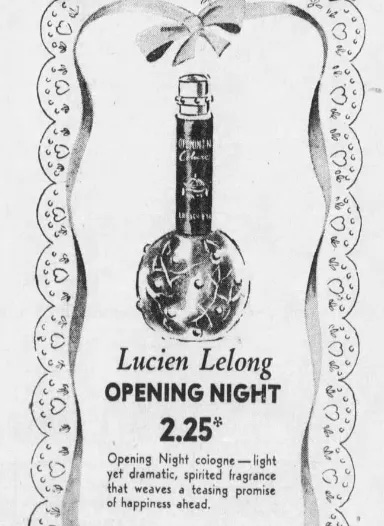
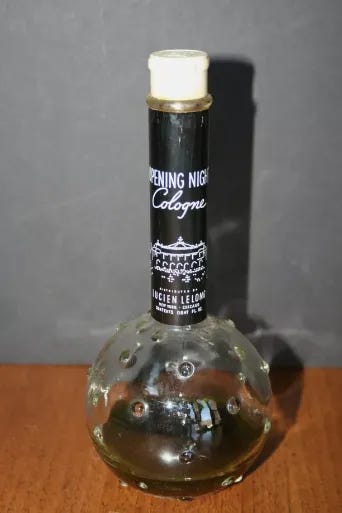
The cologne concentrations of Lelong fragrances were quite affordable and widely available in the mid-1940s and they brought a touch of Parisian couture to women who couldn’t afford a Lelong gown (which was, of course, most women). Opening Night's label includes a sketch of the famous home of the Paris Opéra, also known as the Palais Garnier.
Contemporary ads for Opening Night frequently promised to make the wearer “feel like the star of the performance” or “the star at [her] own beautiful premiere”—perfect for Kitty, who has main-character energy to spare but aspires to maximum glamour with minimum effort. She has even mentioned that she wants to be an actress, and opening night is probably the idea that appeals most to her, rather than auditions or rehearsals, figuratively speaking.
Kitty (dressed in a marabou-trimmed dressing gown and snapping her chewing gum) picks up another bottle and applies its fragrance liberally to her arms while trying to ignore Millie’s reprimands. This scent is packaged in a container shaped like the stepped outline of a skyscraper, very on-trend for this era, although it’s hard to identify precisely. Here’s my best guess:
Bottles like these seem to have been used by a few fragrance brands in the 1930s and 1940s, which makes sense, since Art Deco had filtered down to mainstream commercial goods and there was a taste for merchandise inspired by the rapidly rising skylines of American cities. Here’s one example, a jasmine fragrance by a company named Lander. The “Parfum Modernistic” label is pretty snazzy.
We don’t learn much of Kitty’s back story in Scarlet Street, but it’s a safe guess that she arrived in New York hoping to discover the glamour of big-city life as she’d seen it portrayed on the silver screen and in magazines, to live in a skyscraper penthouse, even to see her own name in lights. By the time we meet her in Scarlet Street, she’s learned that none of this is likely to happen.
Kitty’s dresser-top, in a later scene, also holds assorted accessories and beauty tools like hair ornaments, bobby pins, a comb, a curling iron, empty skincare jars (she’s a bit of a slob), and a perfume in large splash bottle that I haven’t been able to identify yet. (Let me know if you have any ideas…and, apologies for the tiny screen-cap-within-a-screen-cap there!)
She also owns a canister of Coty Air-Spun Face Powder in its classic yellow-and-white powder-puff print.
Looking at a Coty newspaper ad from 1945, I’m delighted to learn that Air-Spun was available not only in assorted shades, but also scented with some of Coty’s iconic (and now long-gone) fragrances. Can you imagine?! I know scented dusting powders for the body used to be widely available, but facial powders, too? at the drugstore? So luxurious.
She also carries a compact of loose face powder in her purse—maybe some Air-Spun that she’s decanted from her larger canister?
Kitty: “Why are looking at me? Is my face dirty?”
Christopher: “No, it's beautiful.”
Kitty: “I’ll bet it is! Gee, I’m a sight.”
Let me know if you end up watching Scarlet Street—it’s easy to find online. It’s definitely not a “feel good” film but it’s one of my favorite examples of film noir and its perfume details are just right, too.

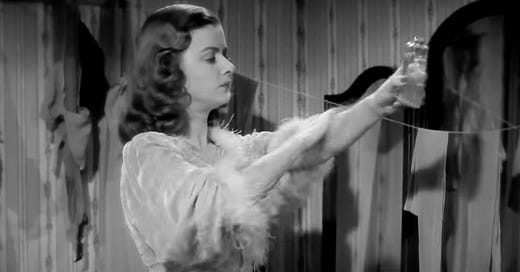


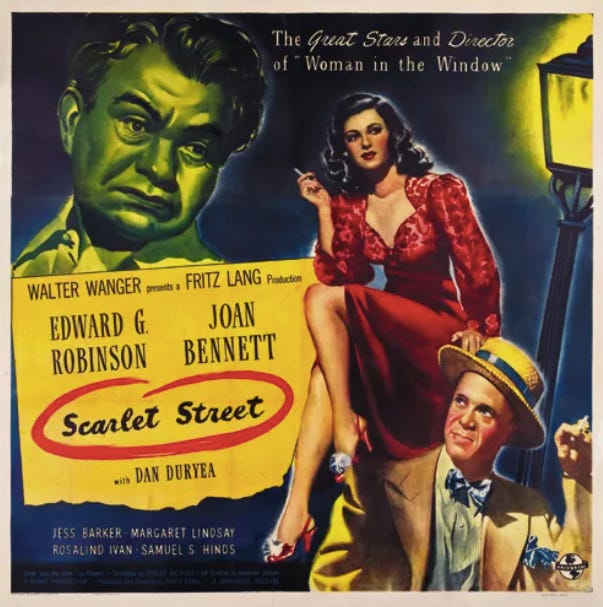

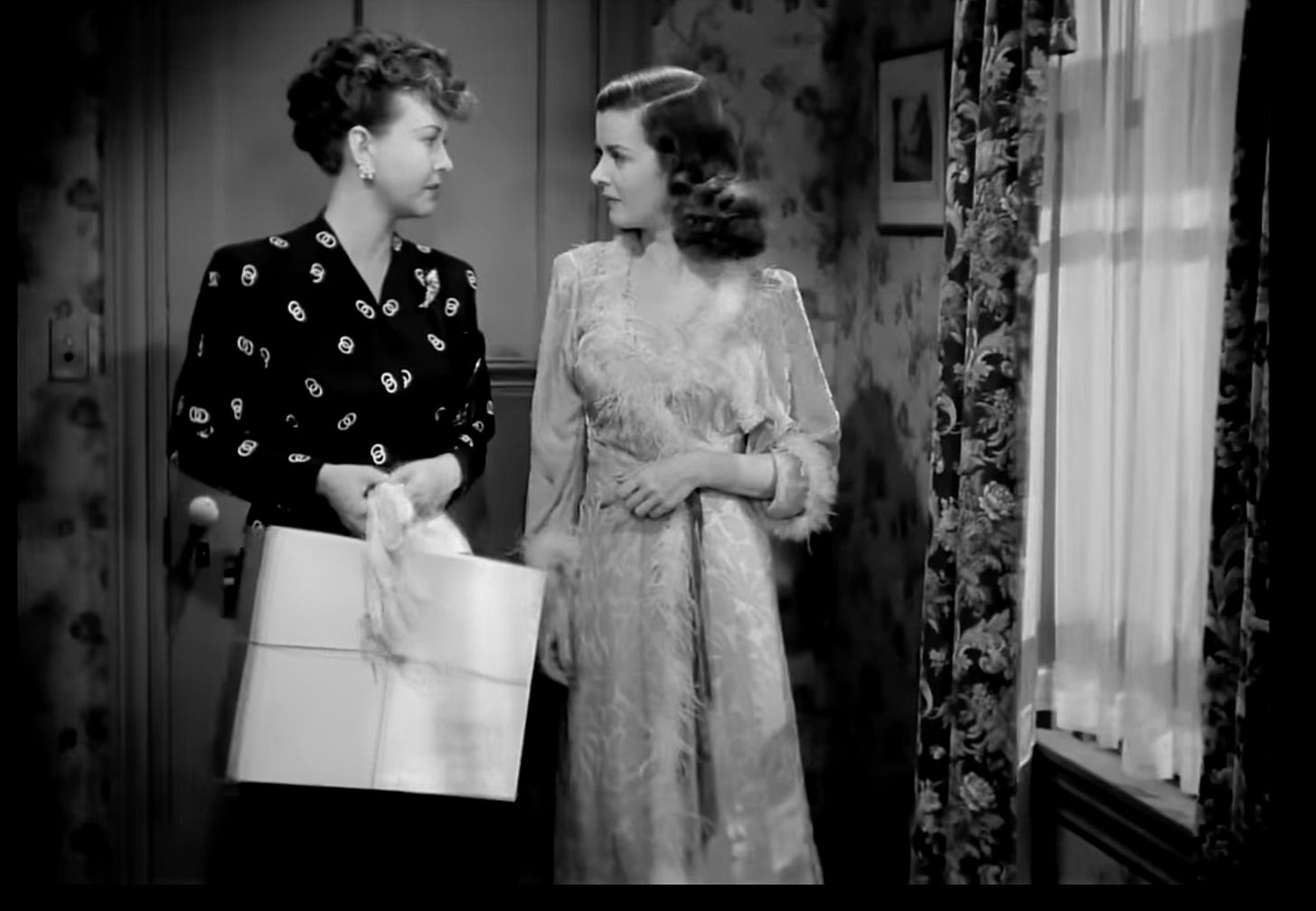






Haven't seen the film but loved seeing the photos you posted here of those fabulous bottles, especially the skyscraper + the COTY AIRSPUN!